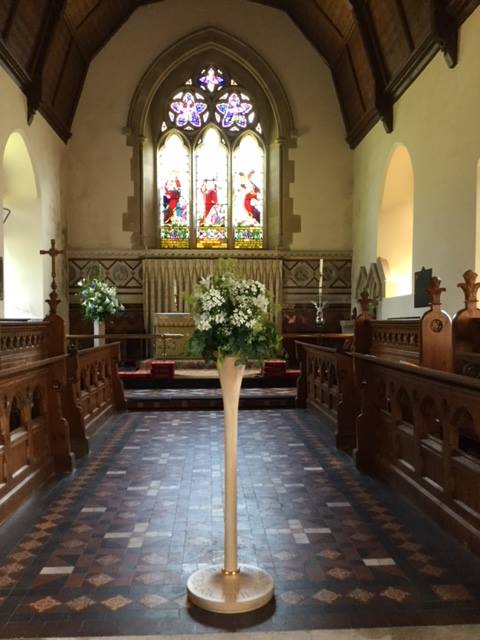
The first known record of Pembury, originally Pepingeberia, is to be found in the “Textus Roffensis” (c.1120) It tells of the manors of Pepenbury Magna (Hawkwell) and Pepenbury Parva (Bayhall). The Advowson was granted by Simon de Wahull to Bayham Abbey c.1239. The plan of the Church and the little Norman window above the South door indicate that the original Church dates from 1147 at least, or even 1100 A.D. If you stand outside you can see the walls of this oldest part - the present nave. Inside, in the corner near the lectern there is the ancient piscina in the wall near where the altar would have been.
Most of the present Church was built in 1337 by John Colepeper of Bayhall. He also built the chantry chapel of St Mary in the churchyard in 1355 but this was pulled down at the Dissolution of the smaller Monasteries in 1547 and the three windows in the body of the Church were inserted with the money gained from the sale of the lead which had covered the chapel.
The most notable feature inside the Church is the roof of the nave. It is said to be one of the best specimens of the tie-beam and kingpost type in this country.
On the north wall near the pulpit there is a brass with an inscription and a figure of an Elizabethan child, Elizabeth Rowe. There are two slabs set in the Sanctuary floor in memory of Dorothy Amherst, 1654 and Richard Amherst, 1664. The Amherst family owned the manor of Bayhall at this time.
During the nineteenth century a number of alterations were made to the Church, including the raising of the Chancel floor. This meant that the oldest tombstone was completely covered over. The inscription round the edge of the stone slab, written in Norman French, tells us that it is the resting place of Margaret, the daughter of Sir Thomas Colepeper.
Among the memorial tablets you will find several to the Woodgate family, three of whom were Vicars of Pembury in the last century. These are mainly in the chancel, and in the tower is a memorial to Lord George Spencer-Churchill.
There are four bells which are now fitted with a chiming apparatus so that they can be rung by one person.
During repair work to the arch between the nave and the tower in 1999, two Lancet windows were discovered, which had been covered by rendering for some considerable time. These windows date from the Norman period, and can be seen high up on the west side of the arch, either side of the blue curtains.
Outside in the churchyard, a few yards along the path to the east of the porch there is a high box vault. In this vault are the remains of Anne West who lived at Bayhall. On the opposite side of the path is a grave with a twin headstone. Here lie the remains of Sir Samuel Morton Peto and his wife. The lych-gate is also a memorial to him.